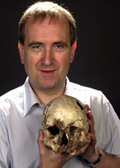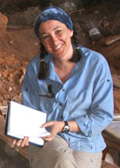Meet our human evolution experts
Find out about the Natural History Museum experts who are illuminating how, when and where humans evolved.
Through collaborations and fieldwork around the world they are revealing what early humans were like and how they lived, as well as how they coped with changing environments and often harsh conditions.
Prof Chris Stringer

Chris Stringer is our foremost expert on human origins, particularly Neanderthals and their relationship to Homo sapiens. His current research focuses on the extinction of Neanderthals and the migration, lifestyles and interactions of ancient humans in Europe and western Asia.
As Director of the Ancient Human Occupation of Britain project (AHOB), Prof Stringer is part of a team investigating the records of early humans and animals in Britain and Europe. This large multidisiplinary collaboration has led to a number of ground-breaking discoveries, including evidence of the earliest humans in Britain, nearly one million years ago.
Prof Stringer's research on Neanderthals has involved work in Gibraltar, one of their last outposts of survival, where he uncovered that they had a sophisticated diet including shellfish and seals.
Using microscopic volcanic glass, he is dating events that may have affected Neanderthals and our own species over the last 100,000 years with greater precision than ever before. This work will help to answer questions about the spread of modern human populations and the demise of the Neanderthals.
Find out more about the AHOB project
Dr Silvia Bello

Silvia Bello's specialty is the evolution of human behaviour.
Through the AHOB project, her research revealed fascinating new information about the behaviour of humans living in Britain nearly 15,000 years ago. Skillfully crafted skull-cups suggest that these people engaged in cannibalism for ritual purposes, not just to alleviate hunger.
Dr Bello is also involved in the Cemeteries and Sedentism project based in Morocco, where she is exploring ancient burial sites and the funerary behaviour of prehistoric human populations.
Find out more about the Cemeteries and Sedentism project
Louise Humphrey

Louise Humphrey specialises in the skeletal and dental development of ancient humans, with a particular interest in the structure and composition of tooth enamel.
With the help of a powerful imaging microscope and the study of the chemical composition of tooth enamel, her research can help unlock evidence of disease, diet and other environmental exposure.
As part of the Cemeteries and Sedentism project, Dr Humphrey explores the diet of populations in north-east Morocco. Humans here made the transition from a nomadic to sedentary lifestyle around 13,000 years ago. The team are investigating the cause of this lifestyle change, and whether it was triggered by changing climate and aridity.